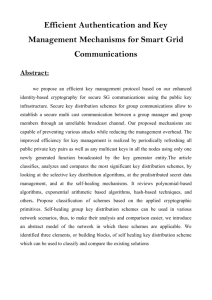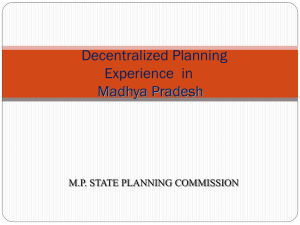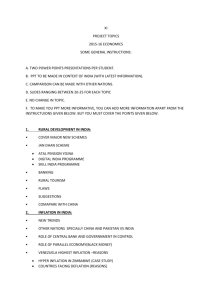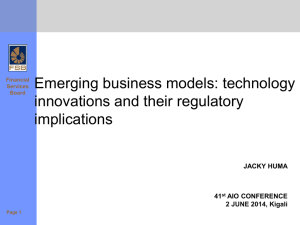MS Word - of Planning Commission
advertisement
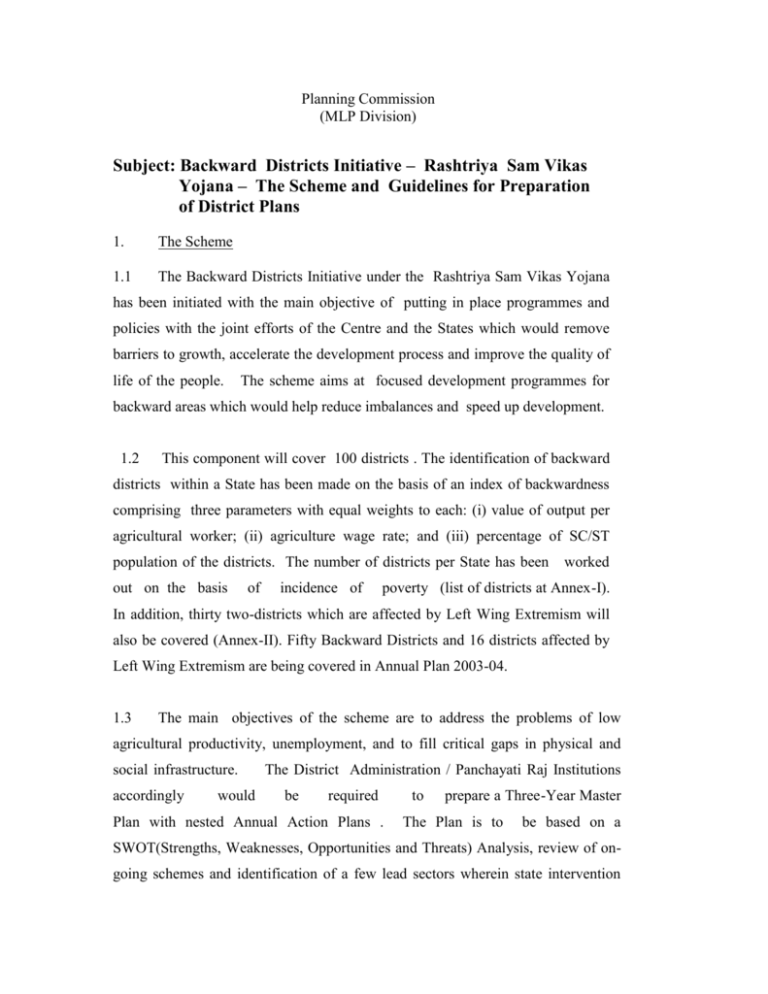
Planning Commission (MLP Division) Subject: Backward Districts Initiative – Rashtriya Sam Vikas Yojana – The Scheme and Guidelines for Preparation of District Plans 1. The Scheme 1.1 The Backward Districts Initiative under the Rashtriya Sam Vikas Yojana has been initiated with the main objective of putting in place programmes and policies with the joint efforts of the Centre and the States which would remove barriers to growth, accelerate the development process and improve the quality of life of the people. The scheme aims at focused development programmes for backward areas which would help reduce imbalances and speed up development. 1.2 This component will cover 100 districts . The identification of backward districts within a State has been made on the basis of an index of backwardness comprising three parameters with equal weights to each: (i) value of output per agricultural worker; (ii) agriculture wage rate; and (iii) percentage of SC/ST population of the districts. The number of districts per State has been out on the basis of incidence of worked poverty (list of districts at Annex-I). In addition, thirty two-districts which are affected by Left Wing Extremism will also be covered (Annex-II). Fifty Backward Districts and 16 districts affected by Left Wing Extremism are being covered in Annual Plan 2003-04. 1.3 The main objectives of the scheme are to address the problems of low agricultural productivity, unemployment, and to fill critical gaps in physical and social infrastructure. accordingly would The District Administration / Panchayati Raj Institutions be required Plan with nested Annual Action Plans . to prepare a Three-Year Master The Plan is to be based on a SWOT(Strengths, Weaknesses, Opportunities and Threats) Analysis, review of ongoing schemes and identification of a few lead sectors wherein state intervention would help the district overcome major bottlenecks in development. The additionality is to be used to meet local needs through schemes in these lead sectors which would make a dent on the poverty of the district in a time bound manner. 2. Release of Funds 2.1 A sum of Rs. 15.00 crore per year will be provided to each of the districts for a period of three years i.e. a total of Rs. 45.00 crore per district . Funds will be released to the State Governments on 100% grant basis in suitable instalments linked with the satisfactory progress of the District Plan. 2.2 The State Government will release the funds received under the programme to a separate head created for the purpose under the District Rural Development Agency within 15 days of the receipt of the said funds. Failure to do so will lead to forfeiture of subsequent instalments and the funds released earlier being treated as a loan. 3. 3.1 Delivery Mechanism There is a High Level Committee at the Government of India (GOI) level chaired by Deputy Chairman, Planning Commission with Finance Minister, Minister of State for Planning, Chief Minister, Government of Bihar, Chief Minister, Government of Orissa and Secretary, Planning Commission as Members. This Committee will approve policies regarding initiatives of the Rashtriya Sam Vikas Yojana (RSVY), set the reform agenda for the State Governments and periodically conduct a review of the progress of the RSVY Programme. 3.2 There is an Empowered Committee at the GOI level chaired by Secretary, Planning Commission which will approve the District Plans, monitor and review the programme, have evaluations and mid-term appraisals conducted and attend to all other matters relating to the operation of the RSVY. -2- 3.3 Each State Government has to set up a State Level Steering Committee under the Chairmanship of the State’s Chief Secretary with about five other members . The Secretaries of the Departments of Finance and Planning, Chief Executive of the District (Deputy Commissioner or Chief Executive Officer of the Zila Parishad), State Level representative of NABARD and an NGO could be members. In the case of districts affected by Left Wing Extremism , this Committee should also include the State’s Home Secretary. The Committee would get detailed district plans prepared and recommend them to Planning Commission for concurrence of schemes. It would be also responsible for coordinating and ensuring synergy between departments and agencies as well as monitoring of the schemes. 3.4 For each district the district plan should be prepared by a District Committee chaired by the District Magistrate/ CEO Zilla Parishad/Chairperson of the District Planning Committee with the District Superintendent of Police (in case of Extremist-affected districts), District Forest officer, local NGOs, other stakeholders, etc. as members. 4. Guidelines for Preparation of District Plans 4.1 For availing of assistance under the Scheme, a three-year Master Plan is to be prepared for each district with nested Annual Action Plans. 4.2 The main principles which have to be taken into consideration are: 4.2.1 The flow of funds from all sources namely State Plan, Centrally sponsored schemes, Central Schemes, externally aided projects etc. are to be indicated along with the specific schemes for the additionality under the Rashtriya Sam Vikas Yojana. Care should be taken to allocate funds under the -3- RSVY as an additionality only for expanded coverage of schemes for which funding from other sources including State Plan, Centrally Sponsored Schemes, Central Schemes are available, on being satisfied about the level of utilization of available resources. 4.2.2 The benefits from RSVY funds should be maximized through inter- sectoral linkages. RSVY funds should also be used to leverage a larger plan size through correlation with the banking sector and beneficiary contribution. 4.2.3 The cost effectiveness of all schemes should be carefully considered so that returns from the funds invested under the scheme are maximized. In other words, inter-se priorities among individual schemes under a programme should be decided on merits only. There should be complete transparency in the choice of schemes and their locations. The prioritised list of schemes and the reasons for taking up the schemes and the criteria for choice of locations must be made available on the web-site. Similarly all tenders should be on the web-site. 4.2.4 Peoples’ participation and involvement of PRIs, NGOs and Self Help Groups should be ensured at every stage including plan formulation, implementation and monitoring. 4.2.5 PRIs, NGOs and Self Help Groups may also be involved in awareness and capacity building, training, etc. and about two per cent of the funds could be utilised for such schemes. 4.2.6 Employment related schemes and vocational training need special attention specially in the districts affected by Left Wing Extremism. However, schemes for self-employment may be based on credit rather than subsidy. Therefore, each project should be made a bankable enterprise and subject to appraisal and banking discipline. -4- The enterprises should be promoted through private / group initiatives and not through the government / government sponsored Cooperative sector. Funds should not be provided to prop up ailing government/ government sponsored cooperative enterprises. The aim is to encourage self employment programmes for income generating activities through small assistance to Self-Help Groups towards revolving fund and provision of training inputs. However, the required infrastructure and subsidy linked schemes may be allowed only if absolutely essential as a supplemental measure for expanded coverage of a Central / State Plan scheme and subsidy should be kept at the same level as that provided in the case of similar Central Government Schemes. For schemes involving creation of community assets efforts should be made to ensure a beneficiary contribution wherever feasible. 4.2.7 Allocation under RSVY may be made only after exhausting in full the assistance available under various Centrally Sponsored/Central Plan/State Plan schemes including those under KVIC, PMRY, SGSY, SJSRY etc. 4.2.8 Funds under RSVY should be used for projects and programmes and not for construction or renovation of administrative buildings , establishment costs/staff costs, and other such schemes. No new posts are to be created for this programme. 4.2.9 All schemes are to be completed within the prescribed three-year time frame. No cost over-run will be permitted. If a project cannot be completed in three years, it can be included only if the State Government gives a commitment to fund it beyond the three year period. 4.2.10 It should be ensured that the schemes are sustainable and assets should be planned with care so that they are useful and maintained even after the scheme is over. Special attention is to be given to sustainability of each project. -5- In the case of community assets, wherever possible future maintenance should be built into the programme , e.g. if a community hall is constructed, individuals who use the hall should be charged so that a corpus fund for maintenance can be set up. 4.2.11 Efforts should be made to concentrate on the poorer pockets and the disadvantaged communities within the district. 4.2.12 The Plan should be based on a vision for the district and not be a mere collection of schemes for which funding from existing sources is insufficient. 5. Steps for the Preparation of District Plans 5.1 The first step would be to conduct a stock taking of the existing situation in the district namely: a resource inventory, existing flow of funds for various schemes, strengths of the district, identification of critical gaps and drawing up of schemes to fill these gaps. In this exercise the PRIs and NGOs should be involved. The potential linked credit plan of the district prepared by NABARD may be used while preparing the district plan to ensure higher flow of credit to the district. The Institution identified for undertaking benchmark surveys/monitoring should be directed to undertake the benchmark survey for critical indicators. 5.2 The Plan should be drawn up as per the Chapter scheme given below and got approved by the State level Steering Committee in consultation with the Principal Adviser/Adviser from Planning Commission who has been assigned the district. 5.3 The Plan is to be sent to Planning Commission where it will be examined by the subject Divisions concerned and either sent back for modification or put up to the Empowered Committee for approval. After the approval of the Empowered -6- Committee and receipt of summary record, the State may sign the Memorandum of Agreement (MOA) and send it to the Planning Commission for signatures (copy of format of MOA at Annex-III ). A copy of the signed MOA will be sent to the State Government and the first instalment of funds will be released for the district. 6. Chapter Scheme 6.1 Each district plan should contain an executive summary highlighting district specific problems and suggested strategy. Each Plan document should have the following Chapters: 1. Background 2. Resource Inventory 3. SWOT analysis and listing of critical gaps 4. Summary of Objectives/ Benefits expected to be achieved after three years 5. Schematic details including time and cost schedules quarter-wise 6. Benchmark Surveys, Monitoring and Concurrent Evaluation 7. Annexes 6.2 Background 6.2.1 This chapter should include the following information: 1. Location particularly in terms of access to capital city and other large consumption centres. 2. Administrative set-up with special reference to the set-up for administering and implementing the backward district initiative. 3. Basic data on population, density and socio-economic indicators compared with State and national averages. -7- 6.3 Resource Inventory 1. Natural Resources e.g. Forests, minerals, rivers and streams, etc. 2. Human Resources e.g. Population in the working age group, level of unemployment, skills available. 3. Infrastructure e.g. roads, railways, telecommunication, irrigation, credit facilities, hospitals and health centres, schools and colleges etc. 4. Institutions including institutions, ICAR vocational institutions, training institutes, polytechnics/ITIs, research engineering colleges,etc. 6.4 5. Effective NGOs, Self Help Groups, etc. 6. Special economic activities of the district. Strengths, Weaknesses , Opportunities and Threats (SWOT) Analysis and Identification Of Critical Gaps 1. Listing of strengths and weaknesses and building on the strengths by overcoming the threats. 2. Listing of administrative structures/rules/laws which hamper development. 3. Identification of areas (spatial) which require specific attention. 4. Identification of communities/groups which need specific interventions. 5. Identification of three-four lead sectors. 6. Identification of critical gaps in these sectors. Note: The district plan should indicate whether schemes should be concentrated on the poorer pockets within the district or should flow to all parts of the district. Similarly, a decision should be taken whether certain groups/communities deserve specific attention. -8- 6.5 Schematic Details: 1. Special focus may be given to the following sectors: - Land and water management including check dams, revitalization of traditional water structures, small lift irrigation projects, mini diversion weirs, etc. - Health infrastructure particularly strengthening of ANM/Anganwadi centres and provision of facilities for institutional deliveries - Education infrastructure - Augmentation of infrastructure for vocational training using the outreach mode in order to upgrade economically relevant skills such as repairs of electrical goods, plumbing, small fabrication, motor cycle/pump repairs, etc. as per the emerging demands in the market as well as local artisan skills in handlooms, sericulture, bee keeping, pottery, woodwork, toy making and other traditional disciplines, etc. - Increase in income from agriculture and allied activities through intensification of agricultural and horticultural practices in compact areas particularly in all the command areas of irrigation sources, on-farm development of the command area for optimal use of water resources, introduction of high value crops suited to dry land farming/local conditions; improving yields from dairying, small animals and pisciculture, etc. through back-up of veterinary facilities and marketing infrastructure. - Filling in critical gaps in physical infrastructure such as vital road links, rural electrification, etc. - Deficiencies identified in Potential Linked Credit Plan prepared by NABARD for the district should be taken care of. - the district may also choose to use up to 15% of the funds on maintenance of assets in the health, education and veterinary sectors. However, visual -9- documentation of the asset before and after the maintenance would have to be furnished. - in the case of districts affected by Left Wing Extremism,7.5% of the total outlay may be earmarked for security related projects e.g. Construction of bridges/roads for providing connectivity to the police forces/para-military organizations. Further, police/para-military organizations may also be involved in the implementation of schemes if found appropriate/feasible. 6.6 Benchmark Surveys/Monitoring 6.6.1 An institution either within or in close proximity to the district, should be identified for the purpose and a sum of Rs. 4 to 5 lakh allocated on annual basis for carrying out benchmark surveys for taking up monitoring and midcourse evaluation of the programme. As a first step existing facilities/resources should be surveyed which will provide a benchmark for future assessments. An MIS should be prepared which will indicate the progress of schemes for each quarter in physical and financial terms. The relevant output indicators for each project should be indicated on a quarterly basis against which progress can be monitored. Output indicators which have long gestation period may also be indicated for evaluation after the end of the scheme period. A strict monitoring schedule should be a part of the implementation process itself. The schemes should be monitored by the State Level Steering Committee / NGOs and quarterly progress reports submitted to Planning Commission for review by the Empowered Committee and the High Level Committee. 6.6.2 A website has to be created for each district which will give the background information for the district, the district plan, results of the benchmark survey and the MIS which has been developed. This should be updated on a weekly basis to show the progress of the schemes. - 10 - 6.6.3 The State Government may also provide relevant visual recordings (photographs / videos) to show the position before the projects are undertaken and after completion of the projects and make an assessment of the impact of the RSVY in improving the economy of the district concerned. 6.7 Annexes 1. Basic Statistics of the District e.g. Demography (Population, density, SC/ST, BPL families, literacy, etc.), land use (area under various types of uses, gross cropped area, cropping intensity, irrigated area, land holdings, etc.), physical infrastructure (roads, railways, electrification, water supply, irrigation, etc.), social infrastructure ( schools, colleges, universities, ITIs, Polytechnics, health centres, hospitals, etc.), economy (workers, agricultural production, animal resources, fisheries, handlooms, small scale industries, other industries, services, etc.) and administrative setup ( panchayati raj bodies, municipality, administrative units, etc.). 2. Basic Statistics of Blocks: Number and type of Panchayati Raj Institutions (PRI), SC/ST population, BPL families, land holding pattern, electrification, drinking water supply, primary schools, ICDS projects, etc. 3. Details of Projects not included in the main body of the report, particularly their financial viability. 4. Any other information pertaining to the district. 7. Illustration of Steps to Prepare the District Plan 7.1 Instead of investing RSVY funds thinly across all sectors, it would be desirable to identify a few sectors in the comparatively backward areas of the district for special intervention in order to have an impact during the three-year period. - 11 - 7.2 The steps enumerated in the table below will be of help in conducting this exercise. 1. Identify three – five lead sectors keeping in view the felt needs of the backward regions of the district. 2. Identification of critical gaps in each sector. 3. Requirement (physical and financial). 4. Existing schemes in the sector. 5. If yes, then assessment of existing flows, existing targets. 6. Expanded targets to be achieved with RSVY funding (along with phasing). 7. Identify links required to other sectors and critical gaps in those e.g. if agriculture is identified as the lead sector and crop diversification scheme is introduced, efforts have to be made to ensure that the entire chain from supply of planting material to development of a competitive market is tied up. Besides, gaps in infrastructure relating to connectivity and assured supply of electricity have to be filled up. - 12 - 7.3 The entire chain of selection of schemes and inter-sectoral linkages may be undertaken. The following box gives a few illustrations:-Identification of schemes in lead sectors and building of backward and forward linkages Example 1: Sector Livelihood Support : Identification of level of unemployment; identification of self-help groups which are credit worthy; identification of skills for which there is a demand, training in skills thus specified, formulation of a pragmatic training programme, etc. Steps to establish credit linkage of SHGs with the Banks. The availability of funds from existing schemes should be assessed and gaps filled through RSVY. The guidelines for SGSY should be followed. However, all schemes should be made bankable. No subsidy will be provided under RSVY and support would be limited to revolving fund assistance, training / skill development and infrastructural support. Example 2 : Irrigation: current sources, potential in the district requirements, current sources of funding, status of ground water, gaps to be met from RSVY. Scheme details eg. Water harvesting structures/ Check Dams/ Lift points / Dug wells with pumps - area to be covered, cost involved, cost-benefit ratio, funding pattern (ratio of subsidy/credit/beneficiary contribution) , phasing, process of handing over operation and maintenance to the beneficiaries/ user groups. Sustainability, particularly, benefits likely to accrue in terms of increase in income so that O & M costs can be paid by the beneficiaries, etc. Further concerted efforts need to be made to ensure that the potential created is utilised properly by providing for on-farm development programmes such as field channels, installation of water regulators and agricultural extension facilities and package of inputs in compact areas which give impetus to crop diversification and adoption of high value crops wherever suitable. Further forward linkages to markets may also be provided. If road links are planned in the district, the area to be served by the check dam / other minor irrigation scheme should be given priority. This will ensure that the income enhancing benefits of the projects are maximized. If shallow tubewells or energisation of pumpsets is contemplated, the need for strengthening the electricity distribution infrastructure of the area should be looked into. Example 3: Sector Education: Existing facilities should be mapped. Locations with absence of facilities should be identified. Fund available under schemes such as Sarva Shiksha Abhiyan and facilities created / being created thereunder should be identified. Existing gaps should be identified such as class rooms, laboratories, libraries, sports facilities, play fields, etc. RSVY funds may be used for such schemes. If level of female education is poor, facilities such as hostels may be considered. However, occupancy position of existing hostels should be considered first. Further, funds for salary of hostel staff, teachers and stipends should be tied up . Example 4: Roads : Identification of uncovered habitations / upgradation required / missing culverts, etc. Setting of targets, e.g. coverage of all 1000 + settlements and Gram Panchayat HQs and important marketing / growth centres. Identify funds available under PMGSY, CRF, etc. as well as funds which could be made available under RSVY. Cost norms should be checked and should not exceed PMGSY norms. Efforts should be made to take up roads with maximum benefits first, e.g. roads which connect schools , health centres and mandis. All roads must be completed within three years. - 13 - 7.4 The programme-wise proposed outlay under RSVY in the identified key sectors can be worked out along with projected availability of resources from other schemes for similar activity in order to achieve convergence of resources and expanded coverage of the programme. The following tables give illustrations in respect of connectivity and education sectors: Sector : Roads & Bridges Programme: Rural Connectivity Table – 7.4.1 Financial Centrally Past Year Outlay (Rs. lakh) Current Year-2 Year -3 Total sponsored/ Year(Year-1) New & New & outlay Central/State Plan New & Continuing Continuing Schemes for rural Continuing Schemes Schemes connectivity Schemes Appd. Actual Proposed Proposed Proposed Outlay Expnd. Outlay Outlay Outlay Pradhan Mantri Gram Sadak Yojana ( PMGSY) State Plan road bridge schemes Sampoorna Grameen Rozgar Yojana (SGRY) Externally Aided Project(s) (EAP) Any other road- bridge scheme RSVY X X Note: Outlays may be assumed at current year’s level or with 10 per cent annual increase. - 14 - Sector : Roads & Bridges Programme: Rural Connectivity Table – 7.4.2 Physical Centrally Current Year-2 Year -3 Total sponsored/ Year(Year-1) New & New & Targets Central/State New & Continuing Continuing Plan Schemes Continuing Schemes Schemes for rural Schemes Targets Targets connectivity Past Year Targets * Targets Achievement Targets PMGSY State Plan road-bridge schemes SGRY EAP Any other road-bridge scheme RSVY X X * Unit must be specified in each case - 15 - Sector: Education Programme: Additional School Buildings / Class Rooms Table 7.4.3 Financial Centrally Past Year Outlay (Rs. Lakh) Current Year-2 Year -3 Total sponsored/ Year(Year-1) New & New & outlay Central/State Plan New & Continuing Continuing Schemes for Continuing Schemes Schemes Additional School Schemes Buildings / Class Appd. Actual Proposed Proposed Proposed Rooms Outlay Expnd. Outlay Outlay Outlay Sarva Shiksha Abhiyan (SSA) State Plan Schemes for construction of School Buildings / Class Rooms Sampoorna Grameen Rozgar Yojana (SGRY) District Primary Education Programme (DPEP) Externally Aided Project(s) (EAP) Any other scheme for School Buildings / Class Rooms RSVY X X Note: Outlays may be assumed at current year’s level or with 10 per cent annual increase. - 16 Sector: Education Programme: Additional School Buildings / Class Rooms Table 7.4.4 Physical Centrally Past Year Targets * Current Year-2 Year -3 Total sponsored/ Year(Year- New & New & Targets Central/State 1) Continuing Continuing Plan Schemes New & Schemes Schemes for Continuing Additional Schemes Targets Targets School Targets Buildings / Achievement Targets Class Rooms SSA State Plan Schemes for construction of School Buildings / Class Rooms SGRY DPEP EAP Any other scheme for School Buildings / Class Rooms RSVY X X * Unit must be specified in each case - 17 - 7.5 The summary of main objectives / benefits expected to be achieved after three years should be listed in the Plan document. The following table gives a few illustrations: Objective Scheme Direct Indirect Output(1)/ Indirect Output(2)/ Output/ Time Time Frame Time Frame Frame 1.Reduce poverty Livelihood No. of Increase in income %Poverty support persons of individual reduction (Training &skill employed/self upgradation / employed/ revolving fund annually assistance to SHGs) 2. Increase (i) Minor Increase in Increase in Increase in income agricultural irrigation (check irrigated area agricultural output / poverty reduction productivity dam) and crop (ii) Crop productivity/ diversification one year (iii) Marketing support 3.Increase school Additional Additional Increase in No. of Increase in enrolment/ School Rooms/ Rooms Students/ 6 Monthly Attendance/ literacy Support for construction/ Report Annual Report libraries; 6 Months and laboratories and provision of other sports teaching and facilities reading materials and other facilities/ 6 months 4. Increase Road Additional Connect habitations Increased connectivity construction / roads / one – with 1000 + connectivity and upgradation and two years population and trade / increase in growth / health income CD works centres - 18 ANNEX-I Rashtriya Sam Vikas Yojana : Backward Districts Initiative List of Districts S. No. 1. Name of the State Andhra Pradesh Name of the District 1.Adilabad 2.Warangal 3.Chittor 4.Mahbubnagar 5. Vizianagaram 2.. Chhatisgarh 1. Bastar 2. Dantewada 3. Kankar 4. Bilaspur 3. Gujarat 1.Dangs 2.Dohad 3.Panchmahals 4. Haryana 1.Sirsa 5. Jharkhand 1.Lohardagga 2.Gumla 3.Simdega 4.Saraikela 5.Singhbhum West 6.Goddha 6. Karnataka 1.Gulbarga 2. Bidar 3.Chitradurga 4.Davangere 7. Kerala 1. Palakkad 2. Wynad 8. Madhya Pradesh 1. Mandla 2. Barwani 3. West Nimar 4. Seoni 5. Shahdol 6. Umaria 7. Balaghat 8. Satna 9. Siddhi 9. Maharashtra 1. Gadchiroli 2. Bhandara 3. Gondia 4. Chandrapur 5. Hingoli 6. Nanded 7. Dhule 8. Nandurbar 9. Ahmednagar 10. Punjab 1. Hoshiarpur 11. Rajasthan 1. Banswara 2. Dungarpur 3. Jhalawar 12. Tamil Nadu 1. Tiruvannamalai 2. Dindigul 3. Cuddalore 4. Naggapattinam 5. Sivgangai 13. Uttar Pradesh 1. Sonbhadra 2. Raebareli 3. Unnao 4. Sitapur 5. Hardoi 6. Banda 7. Chitrakoot 8. Fatehpur 9.Barabanki 10. Mirzapur 11. Gorakhpur 12. Kushinagar 13. Lalitpur 14. Jaunpur 15. Hamirpur 16. Jalaun 17. Mahoba 18. Kaushambi 19. Azamgarh 20. Pratapgarh 14. West Bengal 1. Purulia 2. 24 South Parganas 3. Jalpaiguri 4. Midnapur West 5. South Dinajpur 6. Bankura 7. North Dinajpur 8. Birbhum 15. Assam 1. Kokrajhar 2. North Lakhimpur 3. Karbi Anglong 4. Dhemaji 5. North Cachar Hills 16. Arunachal Pradesh 1. Upper Subansiri 17. Himachal Pradesh 1. Chamba 2. Sirmaur 18. Jammu & Kashmir 1. Doda 2. Kupwara 3. Poonch 19. Manipur 1. Tamenlong 20. Meghalaya 1. West Garo Hills 21. Mizoram 1. Lawngtlai 22. Nagaland 1. Mon 23. Sikkim Sikkim 24. Tripura 1. Dhalai 25. Uttaranchal 1. Champavat 2. Tehri Garhwal 3. Chamoli Total 100 ANNEX-II Rashtriya Sam Vikas Yojana : Backward Districts Initiative List of 32 Extremist Affected Districts State Districts 1. Andhra Pradesh 1.Karimnagar 2.Khammam 3.Medak 4. Nalgonda 5.Nizamabad 2.Bihar 1.Aurangabad 2.Gaya 3.Jehanabad 4.Rohtas 5.Nalanda 6. Patna 7.Bhojpur 8. Kaimur 3.Jharkhand 1.Hazaribagh 2.Palamu 3.Chatra 4.Garhwa 5.Ranchi 6.Latehar 7.Giridih 8. Koderma 9.Bokaro 10.Dhanbad 4.Madhya Pradesh 1.Dindori 5.Chhatisgarh 1.Kawardha 2.Rajnandgaon 3.Sarguja 4.Jashpur 6.Orissa 1.Ganjam 2.Gajapati 3. Mayurbhanj 7.Uttar Pradesh 1.Chandauli ANNEX-III DEVELOPMENT AND REFORM FACILITY (RASHTRIYA SAM VIKAS YOJANA) – BACKWARD DISTRICTS COMPONENT: FORMAT FOR MEMORANDUM OF AGREEMENT MEMORANDUM OF AGREEMENT BETWEEN THE PLANNING COMMISSION AND THE GOVERNMENT OF ……………. This Memorandum of Agreement is made between the Planning Commission and the Government of ……… to affirm the continued commitment of all parties to ensure better governance and economic development in …………District in the State of ……….. and to list out the administrative measures and the Development projects which the Government of ………. will take up, and the support to develop ………. District that the Government of India will provide. PREAMBLE WHEREAS the Planning Commission, Government of India and the Government of ……. are agreed that the development of the identified backward districts is a key requirement for the growth of the State’s economy in particular and the development of the country as a whole; AND FURTHER the Budget Speech of the Finance Minister for the year 2002-03 has set in motion initiatives for a Development and Reform Facility (Rashtriya Sam Vikas Yojana) which will provide critical inputs to break the cycle of poverty and underdevelopment; AND WHEREAS there is a broad agreement between the parties to this Memorandum of Agreement on the administrative measures to be taken up and the projects which have been identified for funding under the Development and Reform Facility (Rashtriya Sam Vikas Yojana). IT IS THEREFORE AGREED BETWEEN THE SIGNATORIES TO THIS MEMORANDUM OF AGREEMENT AS FOLLOWS: The State of ……… is committed to take up the agreed administrative measures and implement the identified projects in order to : (i) (ii) ensure good governance ; and alleviate poverty and achieve a higher level of economic development. 2. This Memorandum of Agreement between the Planning Commission and the Government of …………. , records the steps that the Government of ………. will take in a time bound manner to further the process of development in ………… district and the support the Government of India will provide to the Government of ………. BACKWARD DISTRICTS PROGRAMME OF THE STATE OF ………… (DISTRICT ………..) 3. The State Government undertakes to ensure the progress of schemes taken up under the programme as per the schedule fixed in the District Plan submitted to the Planning Commission and the physical and financial targets fixed as per Appendix - I. Further, the State Government of ………will undertake the following mandatory 4. administrative measures as per the table below: Stability of tenure of at least two years for the Deputy Commissioners of the concerned districts and the Heads of the line departments. Complete transparency in the selection, formulation and implementation of the projects Proactive involvement of PRIs and NGOs Item Tenure Indicator of Time Frame District two year term Commissioner/ Collector Heads of the Department (i) Rural Development (ii) Irrigation two year term (iii) Health (iv) Education Transparency in selection, Development formulation and maintenance implementation of projects and System to be in place within of website two months of the scheme’s tenders on the website along inception; weekly update of with progress progress Proactive involvement of List of projects in which Duration of the scheme PRIs and NGOs PRIs / NGOs are involved in selection/ formulation/ implementation / monitoring 5. The State Government undertakes to earmark a sum of Rs. ______ lakh (Rs. 4-6 lakh) for funding a local institution which would undertake benchmark surveys as well as monitor the projects and provide relevant feedback. 6. The State Government undertakes to provide relevant visual recordings (photographs / videos ) to show the position before the projects are undertaken and after completion of the projects. SUPPORT FROM THE GOVERNMENT OF INDIA 7. To support the Backward Districts Initiative under the Development and Reform Facility in ………. district of ……….. State, the Planning Commission will extend the following support: (i) Subject to the State Government of …….. complying with the Schedule of Implementation given in this MOA and satisfactory progress of schemes, Rs. 15 crore will be released per year for three years under the Development and Reform Facility (Rashtriya Sam Vikas Yojana ). (ii) Assist in capacity building and circulate examples of best practices for good governance. IMPLEMENTATION 8. The key component of this MOA is the acceptance of the administrative measures listed above and the implementation of the projects as listed in Appendix-I. 9. The State Government of _________ will release the funds received under the Rashtriya Sam Vikas Yojana to a separate head created for the purpose under the District Rural Development Agency ( _____ District) within 15 days of the receipt of the said funds. Failure to do so will lead to forfeit of subsequent instalments and the funds released earlier will be treated as a loan. 10. The implementation of the MOA will be monitored on a quarterly basis by the Planning Commission and will be placed before the Empowered Committee for consideration for release of instalments. 11. Through this MOA, the Planning Commission and the State Government of ……….affirm their commitment to undertake the development projects and the administrative measures mutually agreed upon in this agreement. Signed this day the Chief Secretary, Government of ………. Secretary(PC)/ Principal Adviser (DRF) For and on behalf of the State Government of…. For and on behalf of the Planning Commission, Government of India APPENDIX-I Scheme/Project Total Time Phasing of Targets requirement required for expenditure fixed on of funds completion ( a on a quarterly quarterly basis) basis Remarks


